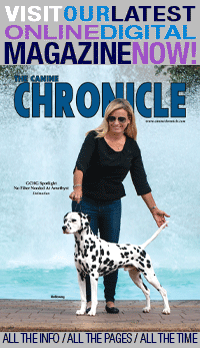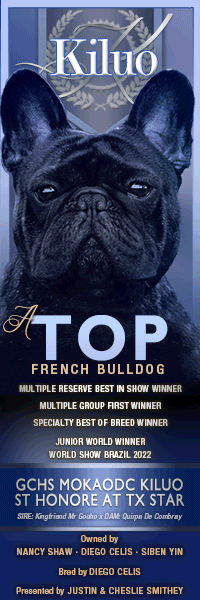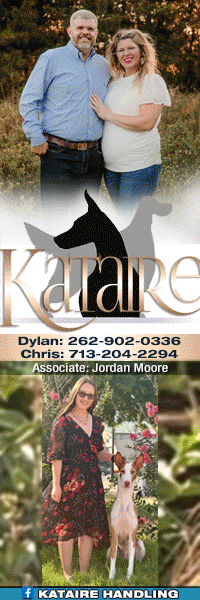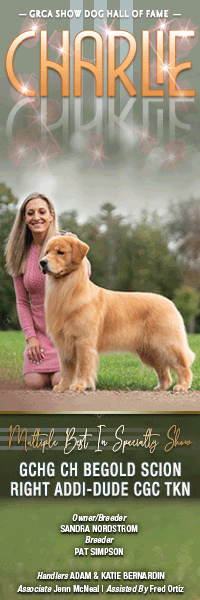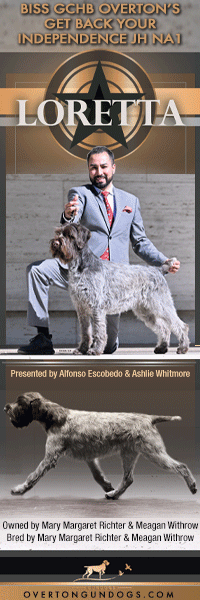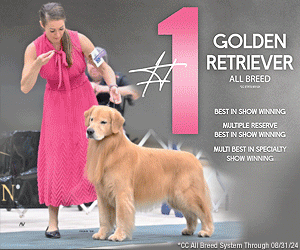A Tale of Two Beaucerons
April 2011
by Joan Harrigan and Susan Beegel
Much is demanded of show dogs – they must be adaptable, calm, and tolerant in addition to meeting the requirements of their breed standards. Two Beaucerons, both champions and exhibited at the 2011 Westminster Kennel Club Dog Show, have show careers that are secondary to their day-to-day work. For Beaucerons Gideon and Elias, ribbons and trophies take a back seat to the life-saving work they perform every day.
The Beauceron’s Working Heritage
Although the Beauceron is a relative newcomer to the AKC (recognized in 2001), this largest of the French herding breeds dates back at least to 1578, when they are mentioned in a Renaissance manuscript. They are large, well-muscled dogs, with short coats of black and tan (bicolor) or black, gray, and tan (tricolor), and Doberman-like cropped ears. The Beauceron should have the fluid, effortless movement and stamina of sheepdogs once used to move herds of sheep or cattle up to 50 miles a day, and a bold spirit – intelligent and full of initiative. High trainability and a strong work ethic mean that the Beauceron excels in many fields of canine work. They were used as messenger and mine-detection dogs during both world wars, and today are used not only for herding, but for personal protection, tracking, police and military work, as well as search-and-rescue and service work.
Ch. De Joie Chateau Rocher, a 120-pound, 3 year-old, black-and-tan boy called “Gideon” was bred by Karla Davis of Woodlake, California and is owned and handled by Marlene Palmer of Klamath Falls, Oregon. Although Gideon has been the cover dog for the American Beauceron calendar, “being handsome is his second job,” says Palmer, “His first job is search-and-rescue.” Certified in the search-and-rescue specialty of wilderness air scent, Gideon and Palmer serve the Klamath County Sheriff’s Department and are on call 24/7, 365 days a year.
Mountainous and heavily forested, the Klamath wilderness encompasses 1.7 million acres straddling the border of southern Oregon and northern California. Home to elk, bear, wild horses, and mountain lion, as well as portions of the Pacific Crest National Scenic Trail, the Klamath is a paradise for all types of wilderness recreation as well as just plain sightseeing. It’s also a very bad place to get lost or injured, and when the summer recreation season is in full swing, the area can generate dozens of search-and-rescue calls.
Palmer began training Gideon for search-and-rescue work when he was an 11 week-old pup; an assistant would hold him while she ran away and hid, and then release the pup to find her and be rewarded. As training progressed, Gideon learned to follow scents from personal articles and locate strangers at greater and greater distances. When he locates someone, he races back to Palmer and fronts, and then flies back to his find as his handler runs after him, trying to keep up. “I’m a lot slower than he is,” Palmer says, “and sometimes he will wind up returning to me four or five times to encourage me to hurry up.” Gideon’s reward is a game with a special tug toy. “At first we trained with treats,” Palmer admits, but her smart dog “started cheating and pretending to find people in order to get them.” She’s understandably proud that Gideon certified at just 14 months-old.
Search-and-rescue is not as romantic as sounds, Palmer cautions. Most of the work involves narrowing a search, as dog-and-handler teams hunt in a grid pattern, eliminating those areas where no scent is found. Sometimes a dog gets unexpected results. Palmer remembers being embarrassed when Gideon alerted on a bear carcass instead of the missing hiker – but the rescue coordinators were thrilled. Gideon had found an important clue, as the hiker had mentioned seeing a dead bear in a last cell phone call to her sister, and the dog’s find – which humans would not have seen in the dark – told rescuers they were on the right track. Gideon’s finest hour was locating a 4 year-old toddler lost in the woods. But even this achievement did not end as expected. The parents may have been relieved, but the little girl was “really mad” laughs Palmer. “She said,‘I am NOT lost! I’m HIDING!’”
It takes faith in rock-solid training for Palmer to feel comfortable letting a much-loved dog off-leash in the wilderness, often in gathering darkness. Gideon wears a bell and a lighted collar to help her keep track of him. There are other hazards too. He has been cut on barbed wire and cut off when on the scent by an aggressive pit bull running loose. Summer weather can be dangerously hot and Gideon sometimes needs a cooling jacket. There are rattlesnakes in the Klamath, and while Palmer has done some snake avoidance training with ropes and hoses, she relies on a strong “LEAVE IT!”
Search-and-rescue work is grueling for Palmer as well as for Gideon—she needs to hike and sometimes run behind her dog for miles, counting her steps on a string of beads so that she can inform rescue coordinators by radio of how many “clicks” they have traveled. Palmer exercises herself and her dog by bicycling, with Gideon trotting alongside.
The team keeps their search-and-rescue skills sharp by training weekly, year-round, regardless of the weather. Their group includes two German shepherds, a Belgian Malinois, a German Shorthair, and several Labs, Palmer says. In addition to tracking, the search-and-rescue dogs also work on related skills such as riding calmly and comfortably in boats, and hot-loading onto a helicopter. These days Palmer and Gideon are working towards a second certification—cadaver dog.
How does Gideon transition to the show ring from his day job? “He’s happy, calm, and confident in the ring,” says Palmer. “I never use a professional handler. We’re a team.”
Gluten-Sniffing Service Work
GCh. Elias Mes Yeux Vigilants is only two, but he’s the first male Grand Champion in the breed, as well as a working service dog with an unusual job. Elias was bred by Susan Bass of Independence, Missouri, and while her “Mes Yeux Vigilants” kennel name translates as “My Watchful Eyes” Elias depends upon scent in his day-to-day work as a gluten-sniffing service dog.
Elias is co-owned by Bass and Hollie Scott, a veterinary student at the University of Missouri at Columbia. Scott’s allergy to gluten became evident when she was in high school, but proved difficult to diagnose. “She kept getting sick and, at one point, was hospitalized for a month,” her mother, Adrienne Scott, explains. No one could pinpoint the cause of her illness until specialists at the Mayo Clinic in Rochester, Minnesota diagnosed her severe allergy to gluten and all its derivatives, whether raw or cooked.
The diagnosis answered questions but didn’t give Hollie Scott a way to live with her condition. “We’d go to a restaurant and she’d be afraid to order anything but water,” says her father, Mike Scott. “If the restaurant had used a knife to cut bread, and then cut her baked potato with it, that would be enough to make her ill.”
Enter Elias. In addition to breeding Beaucerons, Susan Bass operates Canine Specialty Training in Independence. Bass has a background in dog training for the U.S. Department of Defense, working both with service dogs for disabled veterans as well as working military dogs. Now operating her own center, she teaches trainers from as far away as Slovenia and South Africa, as well as doing her own training of service, search and rescue, tracking and scent dogs.
Bass had been showing Elias, but she already had an intact male at home. Trainer Maja Golob had come from her tiny village in Slovenia to work with Bass, and they began to do scent work with Elias. For some reason, Bass trained him with gluten. “The Good Lord must have intervened,” she says. “I’d never used gluten before, but for some reason we used it to train him.”
When Bass had dinner with Hollie Scott and her parents, and Hollie’s Celiac disease was mentioned “a light bulb went off,” Bass says. Elias had been spending time with Hollie and was already starting to alert to her periods of low blood sugar. Bass suggested finishing Elias’ gluten sniffing training, and Scott readily agreed.
Elias was sent to Slovenia to finish his work with Golob, a process that took less than two months. While there, he earned two legs toward his European championship. When he returned, his impact on Hollie’s life was nothing short of amazing. He accompanies her to restaurants where he lies quietly under the table. When the food arrives, Hollie covers the plate with a domed metal plate cover that has a hole in the center. Elias sniffs the hole – if the food is gluten-free, he doesn’t react. If it contains any trace of gluten, he mouths the side of the plate. Originally, the goal was to train him to paw the plate, but Elias prefers mouthing, and Bass recognizes the wisdom of allowing the dog to alert in his own way.
When Hollie required a hospitalization, Elias was able to check her medications to ensure that they did not contain fillers with gluten. “The nurses couldn’t believe it,” Mike Scott says. “To test him, they tried putting a small piece of cracker under a plate, and he alerted to it immediately.”
Bass finds Beaucerons well-suited to service work. “Most of the dogs I work with are Goldens and Labs,” she says, “though I also find dogs at shelters.” She values her service Beaucerons for being “assertive without indiscriminate protectiveness” and for their health. She generally avoids the guardian breeds for service work – “when you put a dog in a stressful situation, you want one that won’t immediately protect,” she says. While the Americans with Disabilities Act does not require that service dogs be “certified” as such, they do prohibit service dogs from being trained for protection.
Bass, who trains service dogs for hearing, mobility, medical response and medical prediction (for conditions such as low blood sugar or seizures) emphasizes the importance of working with a trainer who has been specifically taught to train service dogs. While training a dog to flick a light switch may be possible for most good obedience trainers, matching an individual to the right breed and the right dog takes education and experience.
Elias’ show career isn’t over – there are plans for him to return to Europe to finish his title. However, as with Gideon, his show career takes a back seat to his real job. And when he goes abroad again, Hollie will be with him.
Short URL: http://caninechronicle.com/?p=816
Comments are closed
